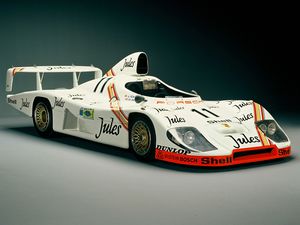.
Porsche 936

| |
| Porsche 936 | |
|---|---|
| Porsche | |
| aka | Porsche 936/77 Porsche 936/81 |
| Production | 1976-1981 |
| Class | Group 5 Racing |
| Body Style | Two-seater, open-cockpit sportscar |
| Length | 4,250 mm |
| Width | {{{Width - type here}}} |
| Height | {{{Height - type here}}} |
| Wheelbase | 2,400 mm |
| Weight | 700 kg |
| Transmission | Five-speed manual, rear-wheel drive |
| Engine | 2,142 cc turbocharged flat-six, air cooled |
| Power | 540 bhp at 8,000 rpm |
| Similar | Renault-Alpine A442 Mirage GR8 |
| Designer | {{{Designer (lead designer if it was a team effort)}}} |
The Porsche 936 was Porsche's flagship racing machine, competing actively from 1976 to 1981, winning three Le Mans 24-hour races. The car was designed as the replacement for the ubiquitous Porsche 917, which the factory retired in 1971. The 936 was to display Porsche's mastery of turbocharging, and as such featured a twin-turbo Boxer engine. The 936 was entered in numerous endurance races and sportscar championships, both by the factory and privateer teams, and achieved considerable success.
The 936/77 - 1976
The 936/77 was the first evolution of the car, and was designed with the sole intention of winning the 1976 World Sportscar Championship. The car faced stiff competition from other vehicles in the Group 5 class, and the team to beat was the factory Renault-Alpine organisation, with their A442. But the 936 was thoroughly developed and engineered, and Porsche was certain 1976 would be their year.
They had reason to be confident. Their challenger was powered by a 2,142 cc flat-six engine, featuring twin-turbochargers at a time when the rest of the cars were only naturally aspirated. The 936 developed a whopping 540 bhp at a heady 8,000 rpm - but the engine, buried deep within the lightweight composite bodywork, required intensive cooling. To solve this problem, the 936 had a prominent air inlet above the driver's head, which led down the rear to a huge rear wing - necessary for high-speed stability. The claimed top speed of the 936/77 was 199 mph.
Needless to say, the 936 won the championship first time out, winning each of the seven races in the World Sportscar Championship, bagging the championship after the fourth race in the hands of Jacky Ickx and Gijs van Lennep. The Martini-Porsche works team scored a double-whammy in 1976, with the 936's smaller brother winning its class too.
The 936 remained pretty much unmodified for the next three years, winning the Le Mans 24-hours in 1976 and 1977. In 1978 and 1980, the car came second - but second was not good enough for the Porsche team. The car was comprehensively redesigned for the 1981 season, the team aiming for Le Mans gold.
The 936/81 - 1981
The 936/81 was treated to a new engine, designed by Hans Mezger, Porsche's chief engineer. The 936/81 was actually a test-bed for its replacement, the Porsche 956, and the 2650 cc turbocharged engine was the component under test. Alongside the new powerplant, the /81 had a revamped aerodynamic package, with the curved flanks and wings of the /77 replaced with an upright rear wing and a longer nose. New forged alloy wheels were developed by BBS, which were two-piece and layered - the top layer channelling air towards the brakes.
The engine itself of similar layout to the previous unit, a twin-turbocharged Boxer. However, instead of being primarily air-cooled, the new unit was a mixture of air- and water-cooled. The first tests of the unit revealed that outputs of upto 800 bhp were possible, but in the interests of reliability, power was capped at 620 bhp - still 80 bhp more than the outgoing 936, in a car weighing only 50 kg more. As a result, top speeds were epic - 223 mph was recorded along Le Mans' 5 kilometre-long Mulsanne Straight.
The 936/81 of Derek Bell and Jacky Ickx won the 1981 Le Mans with a lead of 14 laps over the second-place Rondeau-Ford. The victory marked the 30th anniversary of Le Mans participation for the Porsche factory.
The next year, the 936 was discontinued and replaced with the epic Porsche 956.
